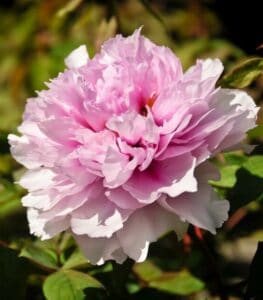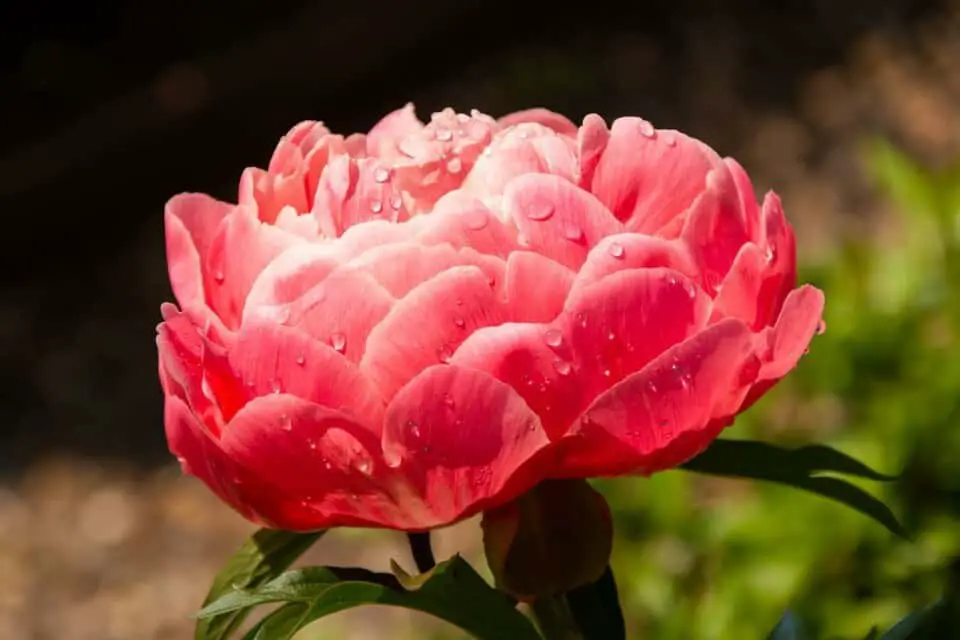Some links in the post are affiliate links and I get a commission from purchases made through some links found in the post.
When buying a plant, gardeners often go through an extensive list of what to do so the plants don’t die. So, it was quite surprising when I got my peony’s care list.
All I had to do was plant it outside in a sunny spot and water it each week. “Won’t the sun destroy its leaves?” I asked, wondering what kind of a plant could withstand the full glare of the sun in my climate.
But the gentleman shook his head and explained that peonies actually love light.
Moreover, since I was getting a herbaceous/ perennial peony, I would never have to worry about too much light. This peony enjoyed bright and direct light even when flowering!
So, I figured my peony would be okay, and such was the case for a long time – until its leaves started curling.
And while sunlight was not the issue, I learned that several factors could cause this change in leaf structure.
The factors that cause the curling of your peony are underwatering, overwatering, over exposure to sun, too much light, overfeeding and pests and diseases.
I’ve detailed them all below and hope you can get a solution to your problem:
Why Is Your Peony Curling and How Can You Fix It?
Some plants look good with curling leaves because that’s part of their aesthetic. But curling leaves do not favor a peony. If anything, they mess up its aesthetic.
Furthermore, they also prevent the plant from making adequate food to promote its growth and the development of buds. Let’s see what could be giving your plant a hard time:
1) Your Peony Needs More Water (Underwatering)
 Peonies require moist soil for most of the active growing season because they have shallow roots. They cannot dig deeper into the soil into the underwater reserves.
Peonies require moist soil for most of the active growing season because they have shallow roots. They cannot dig deeper into the soil into the underwater reserves.
That means that if they don’t get enough rainfall and supplemental watering, they will not have enough water to support their nutrient absorption.
To add insult to injury, the plants will not have sufficient moisture to aid in photosynthesis and regular plant processes.
What causes underwatering?
1) Not having a regular watering schedule
Your peony needs at least an inch of water each week. Sometimes, it can require more owing to an increase in temperatures.
As such, you cannot stick to the same schedule in the summer and the spring. You must adjust it per the season.
2) Soil that drains a lot of water because of a poor water retention rate
Peonies need moist soil. That means sandy soils and others with similar textures would be unsuitable for it as they would allow most of the water to drain.
3) High temperatures
Like most plants, peonies also react to high temperatures in some cases. However, this often shows in newer plants that are yet to get accustomed to their climates.
Also, this can happen if you plant the peony outside its preferred hardiness zones 3 to 9. For example, growing the peony in hardiness zone 10 would pave the way for such an outcome.
How Can You Fix Underwatering?
To ensure your peony gets enough water, you should:
1) Implement a better watering schedule
Water your plant at least once a week. However, you should only do so when the top two inches of the soil feel dry to the touch.
Test this by digging your finger into the soil to the height of your knuckles. Alternatively, you can use a moisture meter to check if the ground is dry.
If the soil needs water, soak it such that the water reaches the bottom of the root ball.
2) Amend the soil to increase its water retention rate
If the soil around the plant has a coarse texture, you will need to amend it with finer soil. Incorporate some compost into the soil to feed the plant and increase its water retention rate.
3) Shade
If your peony species does not enjoy warm temperatures, ensure that you plant it in a space that gets some shade at some point in the day.
Also, keep it moist in the summer and other hot months to help it keep up with the rate of water loss. Ensure its roots are shallow and not deeply entrenched in the soil to allow them space to breathe and take up water.
Adding mulch around the base of the plant is also a good move as it enables your peony to hold on to more water.
You may also like: What are the common peony problems
2) Your Peony Needs Less Water (Overwatering)
While peonies enjoy moist soil, they do not particularly enjoy being in damp environments. After all, their roots are shallow and would sit in water for long periods.
The roots start drowning, unable to take in nutrients, and you notice that your plant shows signs of curling and yellowing.
If you don’t deal with the issue and the plant keeps sitting in water, that creates an ideal environment for fungi to grow and attack your plant. And if you do not check this situation, root rot follows.
What causes overwatering?
- Giving your plant water even when the soil is not dry,
- Using too much mulch,
- Shading your plant too much, and
- Using the wrong kind of soil mix.
Fixing Overwatering Issues
Overwatering is the most dangerous of all the issues that cause curling in peonies. Root rot damages the roots and kills the plant from within.
Sometimes, you notice the issue when it’s too late, and you have no option but to discard the peony and start again. To avoid this, here is how you should care for the peony:
1) Only water the plant when the two top inches of the soil are dry. Please remember that if you live in a rainy region, you may not need to water the peony because the rainfall could be sufficient.
If you have trouble gauging the best time to water the plant, investing in a moisture meter is always a safe choice. Ideally, you should water your plant only once a week unless it dries out too fast.
2) Cut back on the mulch you use around the plant. While it is effective in helping the plant retain moisture, it can also block aeration and increase the water retention rate.
That’s a recipe for harmful fungal growth that can kill your plant. As such, only use an inch of mulch around the peony, leaving at least an inch between the mulch and the plant’s stem.
3) Invest in a soil mix with a medium texture. Loamy soil mixes used for azaleas always work for peonies too. When your soil mix does not drain water, it forces the roots to sit in moisture, compounding the problem.
4) Ensure your plant gets enough access to bright and direct light – this allows it to photosynthesize and use up the water you feed it. Moreover, the light also aids in drying the moisture in the soil.
Dealing with Root Rot in Peonies
 When overwatering goes undiagnosed, fungal growth starts, and the fungi start eating away at the roots and damaging them.
When overwatering goes undiagnosed, fungal growth starts, and the fungi start eating away at the roots and damaging them.
Eventually, the plant grows weak as it cannot take up water and nutrients, and its chances of dying increase. To tell if your peony has suffered root rot, you need to do the following:
1) Check if the soil is waterlogged: If the soil appears damp and has been so for a while, there’s a high likelihood that root rot may have ensued.
2) If there’s a chance of waterlogging, you need to uproot the peony and place it in a sunny spot where the roots can dry. Inspect the roots.
If they appear firm and white, they are healthy and unaffected by root rot. You can then replant the peony in the soil and amend your watering schedule, or whatever has caused the waterlogging.
If the roots appear soft, they have suffered root rot. You must use a sharp and sterilized knife to cut off the affected parts and treat the remaining parts with fungicide.
You can then replant the peony in well-draining and aerated soil to prevent waterlogging in the future.
Moreover, you must deal with whatever caused the waterlogging in the first place to ensure it does not reoccur.
You may also like: Do peonies bloom more than once
3) Your Peony Needs Less Sun Exposure
Peonies come in three categories: the first is the perennial/ herbaceous peony, the second is the tree/ shrub peony, and the third is the Itoh/ intersectional peony.
They all love bright and direct light when they are actively growing. However, when they start flowering, the tree/ shrub peony prefers bright and indirect light.
Otherwise, its leaves start curling, and the flowers may fall off prematurely.
What to Do About It
With thousands of peonies available, it’s best to understand the type of peony you have in your garden and what it prefers. If it would do better in partial shade, you should plant it to the east of your garden.
Here, it can receive the morning sun and remain protected from harsh afternoon rays. Be warned, though, that your peony must get at least 6 hours of light exposure.
Without this, it will not bloom well or at all. The alternative to planting your peony to the east of your garden is to cover it with shade cloth when it gets too hot in the summer.
You may also like: 5 reasons why your peony is drooping
4) Your Peony Needs More Light
You are more likely to deal with this issue than a situation where your peony needs less sun exposure. That’s because peonies generally thrive in the sun as they can make food and support their blooms.
So, if you notice that your plant suddenly seems dull with curling leaves, it could be that it does not have sufficient energy to sustain its cellular activities.
Dealing with Poor Light
The best way to avoid such an issue is to find out how much light your plant needs, how often, and how long. For example, most peonies need bright and direct light (full sun exposure) every day for six hours
So, with an outdoor plant, it’s best to move your plant to an east, south, or west position. You should also get rid of any shade around the plant that could be hindering its access to adequate light.
For indoor plants, you can supplement natural light with artificial lighting. LED lights are a good choice as they don’t use up too much energy and don’t emit heat that could damage the plant’s foliage.
5) Your Peony Needs More Nutrients (Underfeeding)
Peonies are not heavy feeders, but that does not mean that they do not enjoy a nutrient boost occasionally.
If they are in nutrient-deficient soil, they cannot support their food production. What’s more, this robs it of the energy to bloom. When a plant is in this state, its leaves curl to save energy.
Dealing with Underfeeding
You should feed your peony at least once a year. Use a slow-release fertilizer with low nitrogen content (preferably a 5-10-5) at the start of spring diluted to half of its strength.
Please do not use a fertilizer with high nitrogen content, as this will encourage the plant to produce more leaves and could hamper its blooming process.
6) Your Peony is Infested by Diseases or Pests
With peonies, fungal diseases are the common culprits when it comes to infestation. You can tell that this is the case if the plant has black spots coupled with mold on its leaves and stems.
As the disease eats away at the plant, it deprives it of energy, hence the curling. Pests can also be behind the leaf curling.
Examples include thrips, mealybugs, scales, and beetles. These suck on the plant’s juices and make it easier for diseases to affect the now weakened plant.
Dealing with Pests and Diseases
It’s much easier to prevent diseases than to deal with them. And you can do this by ensuring your peony is in well-draining and aerated soil and has adequate light exposure.
However, if they have already affected your peony, you will need to use fungicides to eliminate the disease-causing microorganisms.
You can deal with pests by wiping the plant down with insecticidal soap and following through with neem oil applications.
You may also like: 8 reasons your peony plant is turning brown
How Do You Straighten Peonies?
 If your peony leaves have curled, the easiest way to get them back on track is to deal with the underlying issue. For example, if the plant is underwatered, watering it should enable the plant to perk up soon enough.
If your peony leaves have curled, the easiest way to get them back on track is to deal with the underlying issue. For example, if the plant is underwatered, watering it should enable the plant to perk up soon enough.
In some cases, like those involving foliage damage due to pest infestations and sun exposure, the affected leaves will not straighten. Instead, the new foliage will grow healthy and strong.
In such a case, you can prune the affected leaves. However, you should only do this after the peony has bloomed. Else, you will reduce its chances of full bloom.
Final Thoughts
Underwatering is often the cause of leaf curling in peonies. And that’s what I realized had been bugging my plant. Once I amended the soil, the plant started growing even faster and healthier, and I soon enjoyed a beautiful set of new leaves.
Curling is a sign that your peony is not doing well. If you ignore it, the peony will not develop as it should, keeping it from flowering. So, once you notice the changes, please uncover the cause and deal with it.
Happy Gardening!

